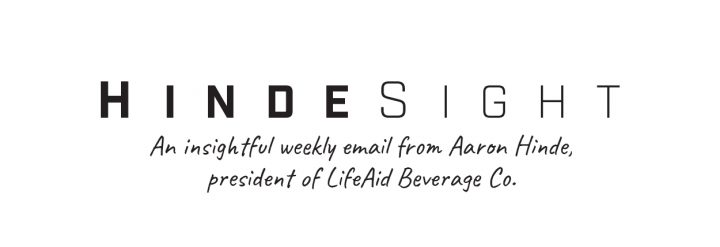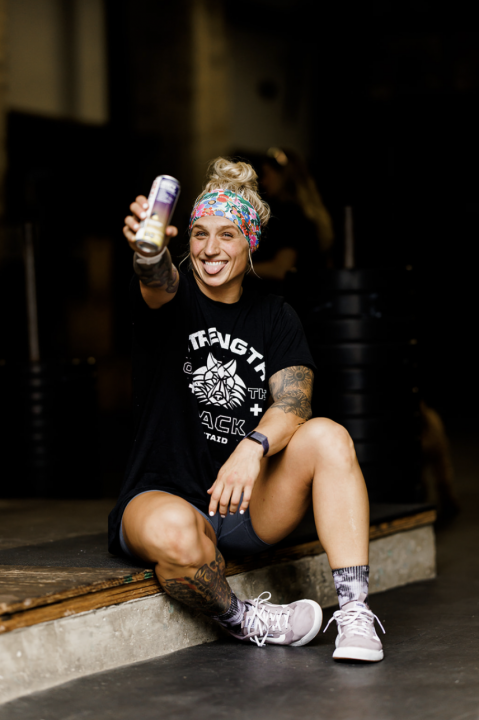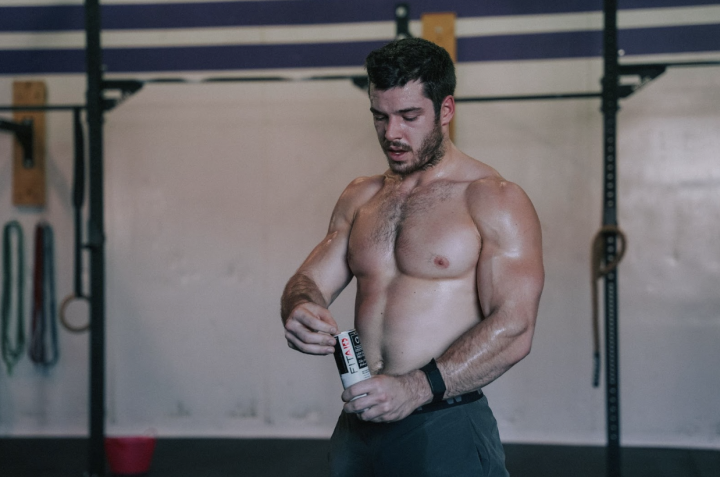
![]()
![]()
Why It’s Harmful to Compare Yourself with Others In this episode of “The Verywell Mind” by Amy Moris we are presented with various different examples of how one might compare themselves to others around them, whether it’s through social media, a friend or a colleague. In this episode, Moris helps us identify different ways we […]

![]()
![]()
Healthy Habits that Last a Lifetime Healthy habits are easier to form than you think! With the right mindset and some willpower, anything is possible. In this episode of Feel Better, Live More hosted by Dr Rangan Chatterjee, guest Professor BJ Fogg provides useful information as to how achieving the implementation of healthy habits can […]
Between August 3rd and the 7th, the greatest athletes in CrossFit will make their way to Madison, Wisconsin to compete for the title ‘Fittest on Earth.’ This year's competition will be some of the toughest in recent history but our FITAID athletes are primed to all have great performances.
After taking nearly a year off to compete in bobsled, Kelsey Kiel and her team (Team CrossFit OBA) dominated at the Granite games! Her team finished second amongst all teams, finishing with 550 total points. Kelsey also killed it with a 200# snatch to help her team secure their ticket to Madison. Be on the lookout for Kelsey and Team CrossFit OBA to dominate again in Madison and podium!

All the way from Brazil, Guilherme Malheiros, or as we like to call him “Gui”, is back in Madison after a very impressive performance last year. Gui won three events, the 550 yard sprint, the heavy clean ladder, and the one-rep max snatch event in 2021 in Madison. As the youngest competitor at last year's Madison Games, Gui would go on to place 7th overall and was awarded the Most Improved Athlete for his efforts. This year, Gui is looking to improve on his 2021 performance and finish atop the competition.

Two of our Canadian athletes will also be competing in Madison this year. After securing their tickets to Madison at the 2022 Atlas Games, Emma Lawson and Jeffrey Adler are looking to continue their 2022 season with great performances in Madison. At only 17 years old and in the CrossFit space now since 2018, Emma is one of the up and coming athletes who is looking to continue her rise amongst the best in the game! With several top 5 finishes in events such as the Atlas Games, Rogue Invitational, and the Open World Championships, Addler is headed to Madison with hopes to take home first place.


Our FITAID athletes competing in Madison round out with our Europe and Australian athletes. These include Gabriela Migala, Lucy Campbell, Nienke van Overveld, Jay Crouch, and Bayden Brown. Whether you are headed to Madison to watch the competition in person or will be cheering from home, be sure to give our social channel a follow @fitaid to stay up on all the action. Also, there may be a social giveaway or two on our social sites so you do not want to miss out!
Between August 3rd and the 7th, the greatest athletes in CrossFit will make their way to Madison, Wisconsin to compete for the title ‘Fittest on Earth.’ This year’s competition will be some of the toughest in recent history but our FITAID athletes are primed to all have great performances. After taking nearly a year off […]

![]()
![]()
Barbell Shrugged with Aaron Hinde In this episode of Barbell Shrugged, I sit down to discuss my career path and how it brought me to the creation of LIFEAID. We cover themes such as adversity, entrepreneurship, and fitness. Have any topics you want to talk about more after listening? Let me know over on Instagram! Listen […]

![]()
![]()
![]()
Managing Stress, Finding Relief Stress. Good or bad? Check out this podcast from San Diego health to learn more about how to make stress a healthy part of your life and avoid the negative consequences that come from living a life encumbered by stress. Listen now… How to be Better at Stress What if you […]
Why Practicing Yoga Benefits Your Health and Well Being
Yoga is more than just physical poses and meditation. It is a way of living that significantly changes your perception of life and improves your overall well being. It includes stretching and is a fun workout that involves spiritual practices such as meditation, prayer, and chants. As a result, anyone who practices yoga experiences numerous physical and mental, and health benefits. It is also known to deeply connect your chakras (centers of strength).
While the word ‘yoga’ comes from the root word ‘yuj,’ which means ‘to bind,’ it has numerous meanings associated with it. In any of these, the underlying meaning remains ‘connection.’ This suggests practicing any type of yoga helps create a connection between your body, mind, and spirit.
Yoga practice offers many physical and mental health benefits for people of all ages. It can help you stay fit, boost immunity, recover from illnesses, relieve stress, and improve sleep, among other benefits. Let’s discuss some of these in detail:
Yoga for Better Health
Overall, well being comprises physical, mental, emotional, and spiritual aspects of life. Yoga is one thing that can help you stay fit in all 4 of these ways. It can reduce stress levels, boost physical energy and endurance, raise your spirits and maintain a healthy emotional balance. Let’s see some of the most common benefits of yoga.
1. Relieves Stress
A study reveals that stress is the second most cited reason that people choose to practice yoga. It can effectively reduce your stress levels and symptoms of psychological disorders like anxiety and depression. Yoga, especially asana, is a great way of dealing with stressful situations and moods.
It is not only the breathing exercises and meditation that promote a calm and positive mood. In fact, the physical aspect of yoga can significantly relieve mental tension and stress. On the other hand, yoga can also help with physical stress to induce stamina and increased energy levels. For instance, it can reduce walking and evening time cortisol levels and lower heart rate.
2. Improves Cardiovascular Health
One review by the Journal of Alternative and Complementary Medicine reveals that practicing yoga can reduce heart disease risk factors such as high blood pressure in hypertensive patients. This suggests that yoga can be beneficial for heart health.
According to another experimental study, patients with heart failure experienced improved heart health after practicing yoga for 8 weeks. Yoga comprises physical activity, meditation, and breathing exercises, so it should be no surprise that people practice yoga to improve their cardiovascular health. Yoga can increase the rate of blood flow to provide more oxygen to the peripheral system, relaxing blood vessels. This suggests that it is quite beneficial for heart failure risk, stroke capacity, and arterial pressure.
3. Combats Sleeplessness
Sleeplessness or insomnia can affect a person’s ability to fall asleep, along with the ability to stay asleep for a suitable amount of time. Many people in the US and around the world are unable to fall asleep and get an adequate amount of rest. As a result, it can lead to unproductiveness, exhaustion, and increased risk of psychological disorders.
Research suggests that practicing yoga before bedtime can significantly improve sleep cycles. It does this by relieving both physical and mental tension and stress to prepare the body for a restful night. Consistent bedtime yoga relieves body aches and mental stress and gets you in the right mindset to fall and stay asleep.
Yoga has numerous benefits for your emotional, mental, spiritual, and physical health. The above-mentioned are the top 3 reasons that most people gravitate towards yoga. It can relieve mental and physical stress, improve cardiovascular health and help you sleep better.
Why Practicing Yoga Benefits Your Health and Well Being Yoga is more than just physical poses and meditation. It is a way of living that significantly changes your perception of life and improves your overall well being. It includes stretching and is a fun workout that involves spiritual practices such as meditation, prayer, and chants. […]

![]()
![]()
![]()



"We don’t make mistakes, just happy little accidents."
- Bob Ross
![]()

Learning the Art of Making Mistakes
What if making mistakes was an art form? This article breaks down the art of making mistakes, from being willing to fail to using our errs as foundations for learning. Author Maggie Wooll explains that “it can be challenging to maintain a positive outlook, especially when we get caught up in the torrent of daily life”, but tough days actually work to fine tune us into the best version of ourselves.
![]()
![]()
![]()


Experiencing Life Fully I had the pleasure of sitting down with Mike Bledsoe to talk about a variety of topics, including one of the lowest points in my life, hitting bankruptcy. We discuss how instead of letting that defeat me, it propelled me to the creation of LIFEAID and gave me a new perspective on […]
Glucosamine: What is it and What are the Benefits?
Glucosamine is a natural substance in the human body. It is found in cartilage whose function is to cushion the major joints during regular movement. It has gained popularity as a supplement thanks to a wealth of scientific evidence that supports a number of health benefits.
What is glucosamine?
Glucosamine is a natural substance found mostly in cartilage. Cartilage is a tough tissue that provides a cushion for the joints.
When glucosamine is taken as a supplement, it is not human but is made in a laboratory or harvested from the shells of shellfish. There are various types, the most common of which are glucosamine sulfate and glucosamine hydrochloride.
Benefits of glucosamine?
Glucosamine is claimed to
- Reduce joint pain
- Reduce inflammation
- Aid bone health
- Tackle glaucoma
The most common use of glucosamine is for osteoarthritis. Much scientific evidence supports its use as a supplement and is also prescribed as medication in the EU. Supplements that combine glucosamine and chondroitin are an excellent alternative for people who do not tolerate NSAIDS (non-steroidal anti-inflammatory drugs).
Glucosamine helps create the fats and protein to repair cartilage when it’s damaged. Remember, damage doesn’t mean physical injury. Cartilage can suffer from overwork, stress, and trauma in the same way as muscles. Aiding the repair function is how the supplement helps to reduce inflammation.
There is evidence that glucosamine supports healthy bone growth by slowing down the weakening of bones that occurs during aging, particularly post-menopause in females.
It is thought that among the antioxidant effects of glucosamine are benefits to the blood vessels in the eye and can improve conditions like glaucoma.
Who should take glucosamine?
Glucosamine can be used by anyone who suffers from any of the conditions outlined above. For sufferers of arthritis, it can reduce inflammation and the associated pain and thereby enable better movement.
It is also useful to athletes. It can aid and speed up the general repair and recovery process after working out or a competition. It is not, however, a medical treatment for specific injuries such as a torn articular cartilage. Medical advice should be sought in this instance although glucosamine may well then be prescribed.
How to take glucosamine?
Glucosamine is not in any foodstuffs so can only be taken as a supplement. It is available in tablet, capsule, powder, or liquid form. It is commonly combined with chondroitin.
LIFEAID’s FITAID beverages are an easy way to get a measured dose of glucosamine along with CoQ10. Available in various flavors, check out the whole lineup here.
Have a LIFEAID fav? Tag us on Instagram! @FITAID
Glucosamine: What is it and What are the Benefits? Glucosamine is a natural substance in the human body. It is found in cartilage whose function is to cushion the major joints during regular movement. It has gained popularity as a supplement thanks to a wealth of scientific evidence that supports a number of health benefits. […]
Essentials for Postpartum Mamas
About three weeks ago, our family grew from 4 to 5 with the addition of our newest babe, Luke. Our other two kiddos are 2.5 year old twins, so this last month has been… crazy, to say the least!
We all are adjusting to our new life as a family of 5, and truthfully, the transition has gone really well so far. It still continues to amaze me though, that every baby is so different - no matter how many other children you have. And not just that, but even as a “seasoned” mama, there are still new tips and tricks I am learning in this newly postpartum stage that have made my life loads easier.
Some of these new tricks are things I really wish I had known during my first pregnancy, so I hope sharing them with you guys will help out some other soon to be mamas (whether you’re pregnant with your first or your fifth!). So what are my essentials for postpartum mamas? Here are my top 3!
-
Prepare with a postpartum kit to keep in your restroom.
One of the things I was so terribly prepared for after the birth of our twins was caring for myself postpartum. The hospital provided a few bare minimum essentials (like a peri bottle and some pads), but aside from that, I really had no idea how to ease the pain of the recovery process after birth.
This time around, I made sure to purchase a MomFrida Postpartum Kit + Upside Down Peri Bottle, and now I won’t stop sharing it with people. It includes disposable boy short underwear, ice pack pads (YES, those are a thing), cooling liners, cooling and healing foam, and the upside down peri bottle. This kit was an absolute lifesaver that first week postpartum!
-
A silicone pump is the most convenient (and inexpensive) way to pump while nursing or on-the-go.
 Photo courtesy of foodandnutrition.org
Photo courtesy of foodandnutrition.org
This is a secret I really wish I knew the first time around! With the twins, I overproduced (a lot) those first few months postpartum. I was constantly pumping, and the worst was getting stuck at the hospital or a doctor's appointment or whatever longer than expected, and being in terrible pain on the drive home because I needed to pump so badly. The twins were also so small and eating so little, that their “meals” never emptied me out and I always needed to pump afterwards. Buying a silicone pump (they are less than $15!), or even two, is an amazing solution. When nursing (or even if you're out and don’t have the baby/your electric pump with you), these suction on to whatever side you aren’t nursing on and collect milk with literally no extra work from mom. Until your baby is old enough to nurse from both sides and really drink the milk you are producing, this is a great solution (and helps you build up a freezer stash of milk too!). Just be sure to have somewhere to periodically empty out the silicone pump - there is nothing like your newborn accidentally kicking the pump off and dumping 3 oz of milk on your couch. Can you tell I share that tip from experience?
-
Even if you exclusively pump, you do not need a SINGLE nursing bra. Here’s why…

Photo courtesy of parents.com
This secret absolutely blew my mind when another mom friend DM’d it to me after I made a comment in a post about needing pumping bras. Nothing is more annoying than wearing nursing bras, then needing a pumping bra to hold your pump in place so you can have some free hands as it does its thing.
This YouTube video shows how to use your nursing bras (yes - the same ones you are wearing all day anyways), and convert them into pumping bras. And, I kid you not, this tip actually holds the pump in place better than the actual pumping bras do!
Not having to constantly swap my bra out throughout the day has been a game changer!
What are some of the other postpartum “secrets” or tips that blew your mind when you discovered them? What are other absolute necessities that a new mom needs in those first weeks? Tag or DM us on Instagram! @FITAID
Essentials for Postpartum Mamas About three weeks ago, our family grew from 4 to 5 with the addition of our newest babe, Luke. Our other two kiddos are 2.5 year old twins, so this last month has been… crazy, to say the least! We all are adjusting to our new life as a family of […]
The Murph Challenge: Who? What? Why?
Whether you're new to CrossFit or not, around Memorial Day Weekend, you have most likely heard about Murph. If you are unfamiliar, Murph, is a classic CrossFit workout known as a Hero WOD. Hero WODs are made to honor the men and women who have fallen in the line of duty. This particular WOD is to honor Navy Lieutenant Michael P. Murphy, who was killed in Afghanistan on June 28th, 2005.
The Murph workout consist of:
- 1 mile run
- 100 Pull-ups
- 200 Push-ups
- 300 Air Squats
- 1 mile run
*With a 20lb vest or body armor
This particular workout, once referred to as “Body Armor” was Murphy’s favorite workout to do. So, every year, Crossfitters around the world pay tribute to Lieutenant Murphy by joining together and completing this workout. Whether you do it alone or at your local gym with your fellow Crossfitters, remember why you are doing it. The Murph is more than just a workout. It is a tradition that helps push us, humble us, and allows us the opportunity to dedicate a bit of pain and sweat to honor Lieutenant Murphy, a man who sacrificed everything he had for our freedom.

Who was LT. Michael P. Murphy?

Here’s an excerpt of what went down on June 28th, 2005 in Afghanistan and what makes Lt. Murphy’s story so impactful:
On June 28, 2005, Lt. Murphy was the officer-in-charge of a four-man SEAL element in support of Operation Red Wing tasked with finding a key anti-coalition militia commander near Asadabad, Afghanistan. Shortly after inserting into the objective area, the SEALs were spotted by three goat herders who were initially detained and then released. It is believed the goat herders immediately reported the SEALs’ presence to Taliban fighters.
A fierce gun battle ensued on the steep face of the mountain between the SEALs and a much larger enemy force. Despite the intensity of the firefight and suffering grave gunshot wounds himself, Murphy is credited with risking his own life to save the lives of his teammates. Murphy, intent on making contact with headquarters, but realizing this would be impossible in the extreme terrain where they were fighting, unhesitatingly and with complete disregard for his own life moved into the open, where he could gain a better position to transmit a call to get help for his men.
Moving away from the protective mountain rocks, he knowingly exposed himself to increased enemy gunfire. This deliberate and heroic act deprived him of cover and made him a target for the enemy. While continuing to be fired upon, Murphy made contact with the SOF Quick Reaction Force at Bagram Air Base and requested assistance. He calmly provided his unit’s location and the size of the enemy force while requesting immediate support for his team. At one point, he was shot in the back causing him to drop the transmitter. Murphy picked it back up, completed the call and continued firing at the enemy who was closing in. Severely wounded, Lt. Murphy returned to his cover position with his men and continued the battle.
As a result of Murphy’s call, an MH-47 Chinook helicopter, with eight additional SEALs and eight Army Night Stalkers aboard, was sent in as part of the QRF to extract the four embattled SEALs. As the Chinook drew nearer to the fight, a rocket-propelled grenade hit the helicopter, causing it to crash and killing all 16 men aboard.
On the ground and nearly out of ammunition, the four SEALs continued to fight. By the end of a two-hour gunfight that careened through the hills and over cliffs, Murphy, Gunner’s Mate 2nd Class (SEAL) Danny Dietz and Sonar Technician 2nd Class (SEAL) Matthew Axelson had fallen. An estimated 35 Taliban were also dead. The fourth SEAL, Hospital Corpsman 2nd Class (SEAL) Marcus Luttrell, was blasted over a ridge by a rocket-propelled grenade and knocked unconscious. Though severely wounded, the fourth SEAL and sole survivor, Luttrell, was able to evade the enemy for nearly a day; after which local nationals came to his aide, carrying him to a nearby village where they kept him for three more days. Luttrell was rescued by U.S. Forces on July 2, 2005.
By his undaunted courage, intrepid fighting spirit and inspirational devotion to his men in the face of certain death, Lt. Murphy was able to relay the position of his unit, an act that ultimately led to the rescue of Luttrell and the recovery of the remains of the three who were killed in the battle.
Lt. Murphy was buried at Calverton National Cemetery less than 20 miles from his childhood home. Lt. Murphy’s other personal awards include the Purple Heart, Combat Action Ribbon, the Joint Service Commendation Medal, the Navy and Marine Corps Commendation Medal, Afghanistan Campaign Ribbon and National Defense Service Medal.
- Murphy Foundation
If you participate in this year’s Murph workout, please share your pictures, videos, and experiences with us on Instagram and be sure to tag @fitaid.
The Murph Challenge: Who? What? Why? Whether you’re new to CrossFit or not, around Memorial Day Weekend, you have most likely heard about Murph. If you are unfamiliar, Murph, is a classic CrossFit workout known as a Hero WOD. Hero WODs are made to honor the men and women who have fallen in the […]


